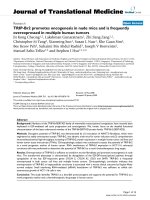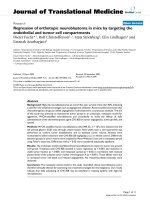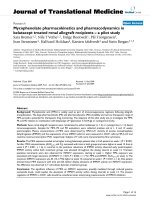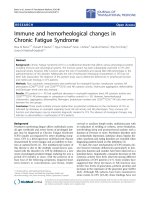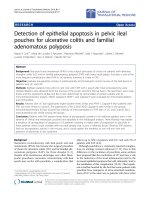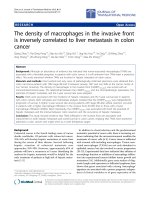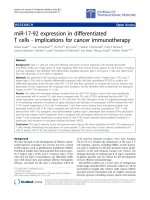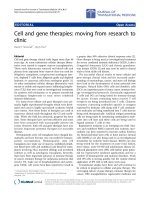báo cáo hóa học:" Is there added risk in resurfacing a femoral head with cysts?" ppt
Bạn đang xem bản rút gọn của tài liệu. Xem và tải ngay bản đầy đủ của tài liệu tại đây (835.75 KB, 7 trang )
RESEARCH ARTICLE Open Access
Is there added risk in resurfacing a femoral head
with cysts?
Thomas P Gross and Fei Liu
*
Abstract
Background: Femoral head cysts have been identified as a risk factor for early femoral failures after metal-on-metal
hip resurfacing arthroplasty (HRA) based on limited scientific data. However, we routinely performed HRA if less
than 1/3 of the femoral head appeared destroyed by cysts on the preoperative radiograph. This study was
undertaken to analyze whether there was an added risk of early femoral failures in HRA when femoral head cysts
were present.
Methods: This retrospective case-control study included 939 MOM HRAs operated by a single surgeon with use of
the posterior minimally invasive surgical (MIS) approach between November 2005 and January 2009. Patients with
all diagnoses except osteonecrosis were included. Among them, 117 HRAs had femoral head cysts ≥ 1cm
identified in surgery. All cysts were treated with bone grafting using acetabular reamings packed into the cavitary
defect (instead of filling the cysts with cement). The control group, which had no cyst observed at the time of
surgery, was randomly selected from our database using computer algorithms to match those cases in the study
group for the parameters of surgical date, age, gender, body mass index, diagnosis, femoral fixation method, and
the size of the femoral component.
Results: The minimum follow-up was 24 months for both gro ups. The early femoral failure rate in the study group
was 3/117 (2.6%) and 0/117 in the control group; there was no statistical difference between these two groups (P
= 0.08). In the study group, there were two femoral neck fractures (revised): both occurred in patients having a
cyst size of 1 cm
3
; and there was one femoral component loosening at 3-year follo w up in a patient having a cyst
size of 2 cm
3
.
Conclusion: Although the risk of early femoral failures among the group with cysts appeared higher than the
group without cysts, we could not demonstrate a significant statistical difference between the two groups. It is
possible that bone grafting cysts rather than cementing them may account for the low failure rate, and that this
technique may minimize the risk of resurfacing a femoral head with cysts.
Background
Hip resurfacing arthroplasty (HRA) wit h metal-on-meta l
bearings has become an established and viable hip
arthroplasty option for the younger patient with higher
activity levels due to bone preservation. This technique
may also make revision surgery less complicated [1,2].
In Europe, the rate of resurfacing has varied between 6%
and 9% with 6% in France, 9% in Germany, and 7% in
the UK [1,3]. In Australia, the hip resurfacing accounts
for 7.9% of all hip arthroplasty procedures. In some
countries, hip resurfacing has been utilized in up to 50%
of all hip arthroplasties in patients younger than 55 with
a low revision rate of 2.8% at five-year follow-up post-
operatively [4,5].
The risk factors for stemmed total hip arthroplasty
(THA) appear to be d ifferent than for HRA
5
, and many
experts have advocated that HRA may be more advisa-
ble in certain subsets of patients with severe degenera-
tive arthritis of the hip. Risk factors have been proposed
that increase the risk for HRA [6-8]. Femoral head cys ts
are widely believed to increase the chances of early
femoral failure in HRA; however, the only scientific data
that exist now to su pport this idea is mainly from Beau-
le’ s study [6,9,10]. In their study, femoral head cysts
were identified as a risk factor for early femoral failure
* Correspondence:
Midlands Orthopaedics, P.A. Columbia, South Carolina, USA
Gross and Liu Journal of Orthopaedic Surgery and Research 2011, 6:55
/>© 2011 Gross and Liu; licensee BioMed Central Ltd. This is an Open Access article distribut ed under the terms of the Creative
Commons Attribution License ( which permits unrestricted use, distribution, and
reproduction in any medium, provided the original work is properly cited.
after met al-on-metal HRA as a p art of the proposed Sur-
face Arthroplasty Risk Index (SARI) [6]. Cysts were
found to be a significant risk factor (P = 0.0 28) for early
femoral fai lure. Our concern is that the te chnique of
managing cysts may be important in achieving a good
outcome. In Beaule’s study, cysts were filled wit h cement;
our technique is to instead fill them with acetabular
reamings prior to cementation or uncemented fixation.
We were not convinced that cysts affected the failure
rate provided that they involved less than one third of
the prepared femoral head and that they were bone
grafted instead of being filled with cement. Because the
scientific evidence to support cysts as an independent
risk factor was limited, we have routinely used this
approach. After many years of experience with these
cases, we have now undertaken this study to indepen-
dently analyze what the added risk of early femoral fail-
ure in HRA was when femoral head cysts were present
and treated with bone grafting. Our hypothesis in this
retrospective case-control study was that femoral heads
with cysts involving less than 1/3 of the prepared
femoral head did not significantly affect the early
femoral failure rate after HRA.
Methods
Institutional review board (IRB) was approved for this
study. From November 2005 to January 2009, the senior
author (T.P.G) performed 939 metal-on-metal HRAs in
831 patients with various primary diagnoses. We excluded
only the cases with osteonecrosis (ON) from the entire
group because we were unable to quantify the amount of
dead bone present in the prepared femoral head in such
cases. Our technique for ON cases was to only remove
loose dead bone and drill the well-fixed dead bone. There-
fore, this technique of treating ON cases did not allow for
quantification of the amount of non-viable bone. Both our
study and Beaule’ s study analyzed the effect of femoral
cysts on the early femoral failure rate before 3 years.
There were no data available to deter mine wh ether cysts
may affect the long-term femoral loosening rate. The pos-
terior minimally invasive surgical (MIS) approach with the
Biomet RecapTM and MagnumTM hip resurfacing system
(Biomet, Warsaw, IN, USA) was used in all cases. In the
first 437 cases, a cemented femoral component was used,
then 502 fully porous femoral prostheses were employed.
The study group consisted of 117 HRAs that had femoral
head cysts (size range: 1 to 4 cm
3
) identified in surgery. A
control group was selected from our database using com-
puter algorithms to match for the parameters of surgical
date, age, gender, body mass index (BMI ), diagnosis, and
the size and fixation technique of the femoral component.
Beginning in July 2006, Dual Energy X-ray Absorptiometry
(DEXA) was utilized to determine the bone mineral den-
sity of patients and recorded as a T-score. Therefore, T-
score data were not available for all patients in this study.
The control group included 117 HRAs that had no cyst
identified at the time of surgery. There were no statistical
differences between the study and the control group other
than the presence or absence of femoral head cysts. All
data on demographics, risk factors, surgical details, and
hospital stay are listed in Table 1.
Details of the MIS surgical procedure were described
in a previous study [11]. In all cases, when cysts greater
than 1 cm
3
were present, they were thoroughly debrided
and grafted with acetabular reamings and platelet c on-
centrate. In the earlier cases in this series, the following
cement technique was used. A 5-mm trough was placed
on the posterior and inferior femoral head for cement
escape. A thin cement mantle was applied to the
femoral head (includ ing over the bone graft) and to the
undersurface of the component. The component was
then impacted, expressing excess cement. No stems
were cemented. In the later uncemented cases, the
femoral component was simply impacted over the
femoral head with an interference fit. The average total
volume of the cysts in the study group was 1.8 ± 0.8
cm
3
(range: 1 to 4 cm
3
) (Table 2 &3). Femoral heads
where total cyst volume was smaller than 1 cm
3
were
not counted as having significant cysts. The cell saver
was used in 17 cases with the average amount of 120 ±
56 cc (range: 30 to 220 cc) in the study group and was
used in 16 cases with the average amount of 132 ± 52
cc (range: 30 to 220 cc) in the study group (P =0.85).
No blood transfusion was required in any case. Other
surgical details are specified in Table 3.
Routine postoperative follow-ups were requested at six
weeks, one year, two years, and every other year after-
ward. Harris hip score (HHS), UCLA activity score, and
visual analogue scale (VAS) pain score were evaluated at
every follow-up visit. Complications and failures were
recorded. Anteroposterior and lateral radiographies were
obtained at each follow-up (Figure 1 ). Radiolucencies,
osteolysis, migration, reactive femoral lines, focal
femoral neck narrowing, and heterotopic bone according
to the Brooker scale[12] were evaluated.
The level of significance was set as 0.05 (a = 0.05) for
all comparison tests in this study. The paired t tests
were performed to compare the numeric variables
between pre-operative and post-operative visits. The
standard t tests were performed to compare the differ-
ences between numeric variables of the study and con-
trol groups. Chi-square tests were performed to evaluate
the difference of categorical variables between these two
groups. The Kaplan-Meier curves were used to analyze
the survivorship rates using revision of femoral compo-
nents as the end point among these two groups. The
Chi-square tests were performed to approximate the
results of the Wilcoxon tests in order to compare the
Gross and Liu Journal of Orthopaedic Surgery and Research 2011, 6:55
/>Page 2 of 7
differences of survivorship functions between groups.
The null hypotheses of all of these tests were that the
survivorship functions were the same between the two
compared groups [13]. Also, the Pearson Chi-square tests
were utilized to compare the differences of failure rates
between groups without considering the time variable.
Results
All patients in this study had a minimum follow-up of 24
months (Table 4). No patients died in the study group.
Two patients died of causes unrelated to the hip surgery
after two years in the control group. Both of them were
included in this study. At the latest follow-up visits, there
were three femoral failures (two in men and one in a
woman) in the study group; there was no femoral failure
in the control group (P = 0.08): two cases (1.7%) were
revised due to femoral neck fracture prior to six months
post-operatively; one (0.9%) was revised due to femoral
component loosening (presumably due to osteonecrosis).
Detailed information is listed in Table 5. The survivor-
ship curves using rev ision of the femoral component as
an endpoint are plotted in figure 2. At 60 months
postoperatively, the survivorship rates of the femoral
components were 97.4% in the study group and 100% in
the control group. However, there was no significantly
statistical difference of failure rates between these two
groups without considering the time variable (P = 0.08)
and there was no significantly statistical difference of sur-
vivorship functions between them (P = 0 .09). In the cyst
group, there was one femoral neck fracture among 53
uncemented femoral components; and there was one
femoral neck fracture and one femoral component loos-
ening that occurred among 64 cemented femoral compo-
nents. There was no significantly statistical difference of
the early femoral component failures between the fixa-
tion of femoral components (P = 0.67).
Excluding the revised cases, the average post-operative
HHS scores at the latest follow-up visit was 97 ± 6 in
the study group and 95 ± 8 in the control group; both
were improved significantly from the average pre-opera-
tive HHS scores, respectively (P < 0.001) (Table 4).
There were no significant differences in the UCLA activ-
ity and VAS pain scores on the regular or worst days.
Radiological analysis revealed that no hip showed evi-
dence of femoral radiolucency or migration.
Discussion
When comparing HRA to stemmed THA, the spectrum
of complications is different. Considering t hat multiple
bearing options are currently available for stemmed
THA, the comparison between HRA and st emmed THA
becomes ev en more difficult. Two complications that are
unique to HRA are femoral neck fractures and
Table 1 Demographic and diagnosis comparison between the groups with or without cysts.
Study Group
– with Cyst
Control Group
– Without Cyst
P-Value
Surgical Date 11/2005 to 1/2009 8/2005 to 12/2008 –
Number of hips 117 117 –
Number of patients 115 115 –
Age at surgery (years) 53 ± 6 (range: 35 to 69) 53 ± 5 (range: 34 to 65) 0.66
Weight (lbs) 189 ± 40 (range: 110 to 290) 186 ± 37 (range: 110 to 275) 0.5
Body mass index 27 ± 4 (range: 19 to 39) 27 ± 4 (range: 20 to 39) 0.59
T-score (Bone mineral density)* 0 ± 1 (range: -2.5 to 3.3) 0 ± 1 (range: -2.4 to 3.5) 0.96
Gender 1
Women 33 (29%) 34 (30%) –
Men 82 (71%) 81 (70%) –
Side 1
Left 53 (45%) 53 (45%) –
Right 64 (55%) 64 (55%) –
Diagnosis 0.7
Osteoarthritis 95 (81%) 95 (81%) –
Dysplasia 20 (17%) 21 (18%) –
Post Trauma 1 (1%) 1 (1%) –
Others 1 (1%) 0 (3%) –
* Not available for all the patients.
Table 2 The information of the cyst size among the study
group.
Size of Cyst (cm
3
) Number Percentage
1 52 44%
2 44 38%
3 15 13%
465%
Gross and Liu Journal of Orthopaedic Surgery and Research 2011, 6:55
/>Page 3 of 7
postoperative femoral head osteonecrosis. We have there-
fore decided to focus on these. In combination, they repre-
sent early femoral component failures after HRA. Proximal
femoral bone preservat ion in young active patients is the
primary reason that metal-on-metal HRA was developed.
However, if the risks of early femoral failures are particu-
larly high in a certain group of patients, they may be con-
sidered poor candidates for HRA. If the alternative risks of
amputating the femoral head and neck to perform a
stemmed THA are much lower in this group, the theoreti-
cal advantage of bone preservation with HRA in younger
patients may no longer be worthwhile. Numerous studies
have focused on delineating risk factors for HSR to help
the surgeon decide which patients may have too high a
risk with HRA to make proximal femoral bone preserva-
tion worthwhile [6,10,14,15]. Unfortunately, it is not
always clear exactly why a certain risk factor is proble-
matic. Does a smaller component size lead to more pro-
blems because of a small area of femor al fixation
5
?Oris
the problem with smaller components primarily because
of more adverse wear problems [10,16,17]. The present
retrospective cas e-control study was specifically underta-
ken to assess one proposed risk factor for early femoral
failures: Does the presence of femoral head cysts increase
the risk of early femoral failure?
Cysts in the femoral head are areas where bone loss
has occurred due to the arthritic process. Therefore, it
is generally believed by experts that femoral head cysts
negatively impact the success rate of HRA [6,9,10].
However, to our k nowledge, only few paper s have
reported scientific evidence that femoral head cysts are
ariskfactorforHRA
5
. Because it seems logical that
cysts might affect femoral fixation, this belief has large ly
gone unchallenged, despite the fa ct that the evidence
available is limited. Beaule et al
5
proposed a SARI on
the basis of a study of 92 HRAs done in pat ients under
40 years of age. The average follow-up was 3 years
(range: 2-5.6 years). Survivo rship with revision for early
femoral failure as an endpo int was 97% (two femoral
neck fractures, one femoral loosening). There were two
additional radiographically loose femoral components
(migration) and eight additional possibly loose femoral
components (complete stem radiolucency). This formed
the problematic group (N = 13). A univariate analysis of
multiple risk factors was done. Points were assigned to
certain risk factors based on their odds ratio in this ana-
lysis. Two points were assigned for cysts > 1 cm
3
,2
points for weight under 82 kg, one point for UCLA
Activity score above 6, and one point for previous hip
surgery. The maximum score was 6. The SARI was
found to be significantly higher in the 13 problematic
hips than in the remainder of the hips in the series (P <
0.001). Femoral head cysts were found in 53% of well-
functioning hips while they were present in 92% of pro-
blematic hips (P = 0.028). Their data implicate the pre-
sence of femoral head cysts (>1 cm
3
) as a risk factor for
HRA. It does not quantify the added risk for failure due
to cysts. Also, the cysts in Beaule’ s study were managed
by debridement and filling with cement.
Our study contradicts these findings (Table 6). Our
study was based on approximately twice as many
patients (117 with cysts in the study group and 117 in
the mat ched control group). The follow-up was similar.
The revision rate for early femoral failure was slightly
less and there were no radiographically loose compo-
nents in our study. Our study group of 117 patients was
compared to a control group that was computer
matched for factors that have been proposed as risk fac-
tors for early femoral failure (see Table 1 &3). In addi-
tion, UCLA activity scores and incomplete data on bone
mineral density sho wed no differences between the two
groups. We could not demonstrate a statistically signifi-
cant difference in the rate of earl y femoral failures when
cysts ≥ 1cm
3
were present in the femoral head. Our
data did indicate that the extra operative time required
in managing the cysts using our technique required on
average 11 minutes (P = 0.004). There are several possi-
ble explanations for this fact. Firstly, although our study
had more power than the comparison study, it is still
possible that a Type 2 error is present. It is possible that
Table 3 Summary of the Surgical Information between the groups with or without cysts.
Study Group
– with Cyst
Control Group
– Without Cyst
P-Value
ASA* 2 ± 1 (range: 1 to 3) 2 ± 1 (range: 1 to 3) 0.33
Hospital stay (days) 2 ± 1 (range: 1 to 5) 2 ± 1 (range: 1 to 7) 0.22
Operation time (min) 120 ± 23 (range: 85 to 242) 109 ± 17 (range: 80 to 168) 0.004
Size of cyst (cm
3
) 1.8 ± 0.8 (range: 1 to 4) 0 <0.001
Femoral component size (mm) 51 ± 4 (range: 44 to 62) 51 ± 4 (range: 44 to 60) 0.78
Fixation of femoral component 1
Cemented 64 64 –
Fully porous coated (Uncemented) 53 53 –
* American Society of Anesthesiologists (ASA) scores.
Gross and Liu Journal of Orthopaedic Surgery and Research 2011, 6:55
/>Page 4 of 7
the presence of femoral head cysts is a weak negative
factor, which our study was not adequately powered to
pick up. But, if this is not the case, the presence of
femoral head cysts should not be a weak risk factor that
should not affect the surgeons’ decision-making process.
Secondly, our management of cysts was different than
that of Dr. Amstutz in the co mparison study [6]. We fill
our cysts with acetabular reamings rather than cement.
This may have positively affected the outcome of our
cases with cysts to the point where no difference could be
Figure 1 Bilateral HRAs, male 43 years old age, the cyst size of 3 cm
3
ontheleftsideandthecystsizeof0cm
3
on the right side;
HHS 97 at both 3-year follow-up (left) and 1-year follow-up (right), primary diagnosis of OA for both side. A: pre-operative x-ray, B: latest post-
operative xray.
Gross and Liu Journal of Orthopaedic Surgery and Research 2011, 6:55
/>Page 5 of 7
found in comparison to cases without cysts. In another
study, Beaule has presented evidence that filling femoral
head cysts with cement can significantly increase the tem-
perature within the femo ral head. This may lead to more
devascularization and a higher rate of complications if the
cement filling technique is used. In the present study, we
couldnotfindthedifferenceinthefailureratebasedon
the method of femoral fixation chosen. Furthermore, our
previous comparative study has shown no difference in
the early failure rate of HRA performed with hybrid or
uncemented fixation [18]. In Beaule’s study, there were 3%
revisions due to early femoral failure, but also 2%
Table 4 Summary of clinical outcomes between the groups with or without cysts.
Study Group
– with Cyst
Control Group
– Without Cyst
P-Value
Period of follow-up (months) 42 ± 11 (range: 24 to 61) 45 ± 12 (range: 24 to 65) 0.08
Pre-operative information
HHS score 54 ± 12 (range: 24 to 91) 55 ± 13 (range: 21 to 83) 0.2
Post-operative information
HHS score 97 ± 6 (range: 68 to 100) 95 ± 8 (range: 71 to 100) 0.22
UCLA score 8 ± 2 (range: 4 to 10) 8 ± 2 (range: 3 to 10) 0.95
VAS score in the regular day 0 ± 1 (range: 0 to 4) 0 ± 1 (range: 0 to 4) 0.59
VAS score in the worst day 1 ± 2 (range: 0 to 8) 1 ± 2 (range: 0 to 7) 0.27
Femoral radiolucency 0 (0%) 0 (0%) 1
Number of femoral failures (revisions) 3 (3%) 0 (0%) 0.08
Deceased 0 (0%) 2 (1.7%) 0.16
Table 5 Detailed information of early femoral component failures in the group with cysts.
Time after surgery
(Months)
Cyst size
(cm
3
)
Femoral size
(mm)
Primary
diagnosis
BMI Gender Age Reason of failure Treatment of
failure
0 1 48 Dysplasia 23 Female 49 Femoral Neck Fracture Femur Revised
1 1 52 OA 35 Male 59 Femoral Neck Fracture Femur Revised
37 2 58 OA 27 Male 53 Femoral Component
Loosening
Femur Revised
Figure 2 Kaplan Meier Survivorship Curves of the group with cyst and the group without cyst after metal-on-metal HRA with 95%
confidence interval using femoral component failures as the end point (P = 0.09).
Gross and Liu Journal of Orthopaedic Surgery and Research 2011, 6:55
/>Page 6 of 7
radiographically loose components, and 8.7% possibly
loose components for a total of 14% “problematic hips”.
We had only 1.5% total problematic hips in our study. But
the studies are not directly comparable. Our patients were
older (which may increase the complication rate) and did
not include the diagnosis of ON (which may decrease the
complication rate).
Conclusions
In summary, our study, with a control group matched for
other previously proposed risk factors for early femoral
loosening, could not demonstrate that femoral head cysts
were an independent negative risk factor for failure of the
femoral resurfacing component. However, we caution
that this may be due to the way we treat femoral head
cysts with bone grafting, rather than filli ng them with
cement. We therefore recommend that the presence of
cysts within the femoral head, as long as they comprise
less tha n 1/3 of the remaining prepared femoral head, be
eliminated as a risk factor for HRA . We suggest that
other surgeons consider bone grafting cysts rather than
filling them with cement. Comparison studies to further
compare these two techniques would be valuable.
Authors’ contributions
TPG designed this study, collected the data, and drafted the manuscript. FL
designed this study, analyzed the data, performed statistical analyses and
drafted the manuscript. All of the authors read and approved the final
version of this study.
Competing interests
The authors wish to disclose that Thomas P. Gross receives the royalty from
Biomet.
Received: 16 February 2011 Accepted: 17 October 2011
Published: 17 October 2011
References
1. Mont MA, Schmalzried TP: Modern metal-on-metal hip resurfacing:
important observations from the first ten years. J Bone Joint Surg Am
2008, 90(Suppl 3):3-11.
2. Ball ST, Le Duff MJ, Amstutz HC: Early results of conversion of a failed
femoral component in hip resurfacing arthroplasty. J Bone Joint Surg Am
2007, 89:735-741.
3. Huo MH, Parvizi J, Bal BS, Mont MA: What’s new in total hip arthroplasty. J
Bone Joint Surg Am 2008, 90:2043-2055.
4. Buergi ML, Walter WL: Hip resurfacing arthroplasty: the Australian
experience. J Arthroplasty 2007, 22:61-65.
5. Sibanda N, Copley LP, Lewsey JD, Borroff M, Gregg P, MacGregor AJ,
Pickford M, Porter M, Tucker K, van der Meulen JH: Revision rates after
primary hip and knee replacement in England between 2003 and 2006.
PLoS Med 2008, 5:e179.
6. Beaule PE, Dorey FJ, LeDuff M, Gruen T, Amstutz HC: Risk factors affecting
outcome of metal-on-metal surface arthroplasty of the hip. Clin Orthop
Relat Res 2004, 418:87-93.
7. Marker DR, Seyler TM, Jinnah RH, Delanois RE, Ulrich SD, Mont MA: Femoral
neck fractures after metal-on-metal total hip resurfacing: a prospective
cohort study. J Arthroplasty 2007, 22:66-71.
8. Beaule PE, Campbell P, Shim P: Femoral head blood flow during hip
resurfacing. Clin Orthop Relat Res 2007, 456:148-152.
9. Mont MA, Seyler TM, Ulrich SD, Beaule PE, Boyd HS, Grecula MJ,
Goldberg VM, Kennedy WR, Marker DR, Schmalzried TP, et al: Effect of
changing indications and techniques on total hip resurfacing. Clin
Orthop Relat Res 2007, 465:63-70.
10. Amstutz HC, Beaule PE, Dorey FJ, Le Duff MJ, Campbell PA, Gruen TA:
Metal-on-metal hybrid surface arthroplasty: two to six-year follow-up
study. J Bone Joint Surg Am 2004, 86-A:28-39.
11. Gross TPML, Fei PhD: Minimally Invasive Posterior Approach for Hip
Resurfacing Arthroplasty. Techniques in Orthopaedics 2010, 25:39-49.
12. Brooker AF, Bowerman JW, Robinson RA, Riley LH Jr: Ectopic ossification
following total hip replacement. Incidence and a method of
classification. J Bone Joint Surg Am 1973, 55:1629-1632.
13. John D, Kalbfleisch RLP: The Statistical Analysis of Failure Time Data Wiley-
Interscience; 1980.
14. Vail TP, Mont MA, McGrath MS, Zywiel MG, Beaule PE, Capello WN: Hip
resurfacing: patient and treatment options. J Bone Joint Surg Am 2009,
91(Suppl 5)
:2-4.
15. Amstutz HC, Wisk LE, Le Duff MJ: Sex as a Patient Selection Criterion for
Metal-on-Metal Hip Resurfacing Arthroplasty. J Arthroplasty 2010.
16. Glyn-Jones S, Pandit H, Kwon YM, Doll H, Gill HS, Murray DW: Risk factors
for inflammatory pseudotumour formation following hip resurfacing. J
Bone Joint Surg Br 2009, 91:1566-1574.
17. De Haan R, Campbell PA, Su EP, De Smet KA: Revision of metal-on-metal
resurfacing arthroplasty of the hip: the influence of malpositioning of
the components. J Bone Joint Surg Br 2008, 90:1158-1163.
18. Gross TP, Liu F: Comparison of Fully Porous-Coated and Hybrid Hip
Resurfacing: A Minimum Two-Year Follow-Up Study. Orthopedic Clinics of
North America 2010.
doi:10.1186/1749-799X-6-55
Cite this article as: Gross and Liu: Is there added risk in resurfacing a
femoral head with cysts? Journal of Orthopaedic Surgery and Research
2011 6:55.
Table 6 Comparison of the results between Beaule & Amstutz’s study and the present study.
Beaule & Amstutz [6] Gross & Liu
Publish year 2004 2011
# of patient 92 234
# with cysts > 1 cm
3
54 117
# without cysts 38 117
Follow-up length (yrs) 3 (range: 2 to 5.6) 3.5 yr (range: 2 to 5.4)
UCLA activity score 7.1 8
Femoral revision rate 3% 1.3%
Femoral migration 2% 0%
Femoral radiological loosening 8.7% 0%
P value of femoral component failures between cyst and non-cyst group 0.028 0.08
Gross and Liu Journal of Orthopaedic Surgery and Research 2011, 6:55
/>Page 7 of 7
